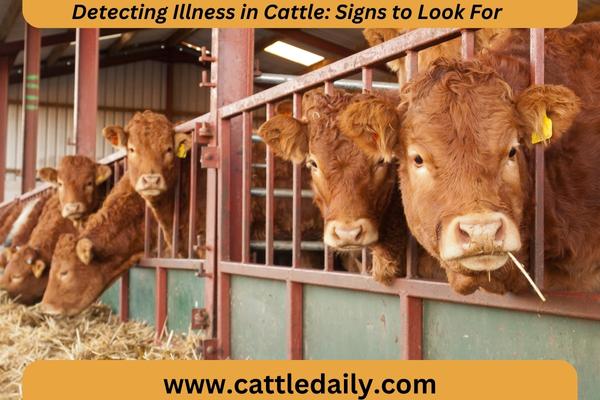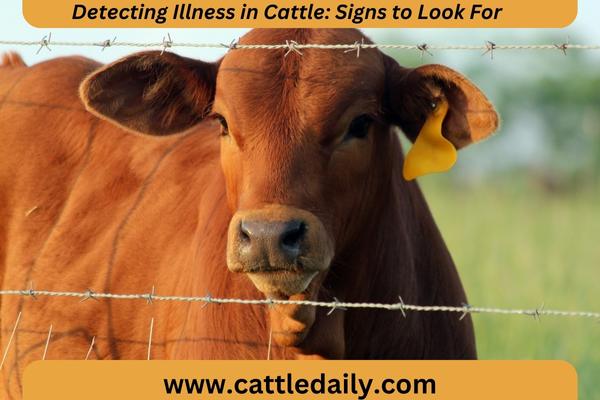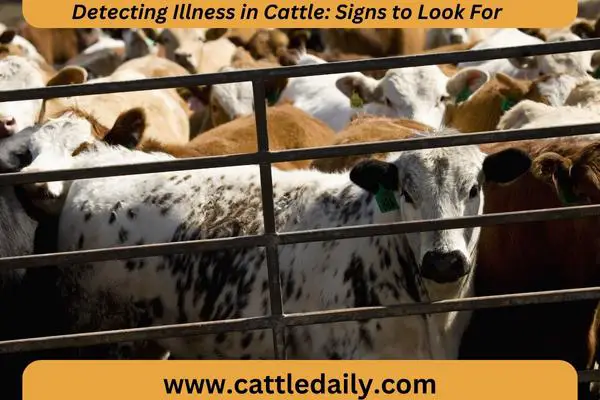Detecting Illness in Cattle
As a cattle farmer, keeping your herd healthy is critical for productivity and profitability. Catching illnesses early allows you to isolate sick animals, get them treatment, and prevent the spread of disease through your herd.
In this blog article, we will teach you the common signs of illness to look for so you can promptly detect and address health issues in your cattle.
What Are the General Signs of Illness in Cattle?
There are some overarching symptoms that can indicate your cattle aren’t feeling well. Watch for changes in:
- Appetite – Cattle that go off feed or have markedly decreased appetite could be fighting illness. Lack of eating leads to weight loss.
- Attitude – Animals that become less alert, slow-moving, less social, or otherwise act “off” may be under the weather.
- Appearance – Dull hair coat, hair standing up, droopy ears, hunched posture all hint sickness. Discharges from eyes, nose, or mouth are also problematic.
- Activity Level – Cattle that are less active than normal, isolate themselves from the herd, spend more time lying down, or seem stiff or lame could be ailing.
- Vital Signs – Elevated temperature, increased heart or respiratory rate, and dehydration checked by skin tent test indicate issues.
Keep these general barometers in mind as you assess each animal daily. Also, watch for signs of specific common cattle illnesses covered next.

Most Common Cattle Diseases and Their Symptoms
Cattle can suffer from a variety of contagious and non-contagious illnesses that impact different body systems. Being able to accurately recognize condition-specific symptoms allows prompt diagnosis and treatment. Here are some of the most prevalent cattle diseases to monitor for:
Digestive Diseases
Digestive issues can cause diarrhea, dehydration, and nutrient deficiencies. Main illnesses include:
1. Bovine Viral Diarrhea (BVD)
Highly infectious disease transmitted by contact with bodily fluids. Acute symptoms are:
- Watery, bloody diarrhea leading to dehydration
- Fever of 104-106°F
- Severely reduced appetite and weight loss
- Skin lesions on the muzzle, in mouth, and on teats
- Pneumonia when immunity depressed
2. Johne’s Disease
Chronic bacterial intestinal infection causes malabsorption of nutrients. Signs are:
- Intermittent, non-bloody diarrhea leading to weight loss
- Bottlejaw from protein loss
- Normal appetite early then reduced as the disease progresses
- Fecal shedding transmits to other cattle
3. Hardware Disease
Ingesting sharp metal pieces that settle in the stomach lining or pierce through. Seen as:
- Repeated arching of back due to stomach pain
- Reduced appetite and low rumen contractions
- Labored breathing if lungs pierced
- Increased lying time and reluctance to move
- Fever, dehydration, and teeth grinding as the condition worsens
Respiratory Illnesses
Contagious respiratory diseases spread quickly through herds. Major types include:
4. Bovine Respiratory Disease (BRD)
Viruses and bacteria infect the upper and lower respiratory tract. Key signs are:
- High fever of 104-107°F
- Moist, painful cough with copious nasal discharge
- Rapid labored breathing over 40 breaths/minute
- Severely depressed activity levels
5. Bovine Respiratory Syncytial Virus (BRSV)
Extremely contagious virus infecting lower airways. Seen as:
- Sudden high fever of 104-108°F
- Harsh, painful cough with wheezing
- Rapid shallow breathing with abdomen held tight
- Frothy nasal discharge
- Spread by aerosols so infections sweep through herd
6. Tuberculosis
Bacterial infection often in lungs and lymph nodes. Chronic debilitating signs:
- Low fluctuating fever
- Coughing with copious nasal discharge as lungs damaged
- Labored breathing from lung tissue scarring
- Reduced appetite and gradual muscle wasting
Reproductive Issues
Diseases of reproductive tracts causing infertility and abortions:
7. Brucellosis
Bacteria are transmitted by aborted fetuses and birthing fluids. Leads to:
- Abortions in late-term pregnant cattle
- Stillborn or very weak calves
- Retained placenta in recently calved cows
- Infertility in bulls and cows
8. Leptospirosis
Bacterial disease is spread by urine. Main symptoms:
- Abortions and stillborn calves
- Premature or underweight calves
- Infertility in cattle affects long-term
Lameness & Limb Issues
- Foot Rot
- Laminitis with limping
- Swelling above hoof
- Foul foot odor
- Lame Calf Syndrome
- Sudden limping
- Warm, swollen joints
- Reluctance to move
- Hardware Disease
- Arched back
- Stiff gait
- Reluctant to move
- Loss of appetite
Now that you know what symptoms typify common cattle illnesses, let’s cover how to practically check for signs of sickness in your herd.

Steps to Identify Sick Cattle
Follow this thorough multi-step process when examining your herd for illness:
1. Scan Surroundings
Assess the conditions cattle are kept in as unhygienic environments allow diseases to spread rapidly. Specifically, check:
- Standing water, mud, areas cows congregate in – prime areas to harbor bacteria
- Manure management – improper handling raises infection risk
- Feed trough cleanliness – contaminated partially eaten feed transmits illness
- Stocking density – overcrowding stresses cattle and depresses immunity
2. Assess Herd Dynamics & Behaviors
Observe behavioral indicators across the herd:
- Activity level and distribution – sick animals isolate themselves, and spend more time lying down
- Interest in food – poor appetite in several cattle hints illness
- Social interactions – lack of grooming, mounting, and playing could reflect sickness
3. Observe Appearance & Hygiene
Unhealthy cattle display poor coat, dirty hindquarters, and eye/nasal discharges:
- Hair loss, dull coat, hair standing up, and skin lesions are all problematic
- Manure and mud build-up on legs/udders means cattle can’t groom
- Cloudy eyes, increased tear production, or nasal discharge suggest infection
4. Check Vital Signs
Take temperature, pulse, respiration rates. Outside normal ranges indicate issues:
- Temperature – Over 103°F could represent infection
- Heart Rate – 100+ beats per minute may signal distress
- Breathing Rate – >50 breaths per minute hints pneumonia
Compare this to the herd baseline you have established when cattle were healthy.
5. Listen to Breathing Sounds
Use a stethoscope on both sides of the cattle chest to detect:
- Increased lung sounds like wheezing or crackling which signify pneumonia
- Painful, moist coughs show lower airway infection
6. Scan for Movement Issues
Observing cattle walk checks for lameness:
- Reluctance to get up, stiffness, and limping are all problematic
- Check for injuries, and swelling – common in lame cattle
- Overgrown hooves also cause lameness
7. Examine Udders & Genitals
Swollen udders, testes, and discharges indicate reproductive issues:
- Hot, painful udders show mastitis
- Swollen prepuce in bulls may reflect balanoposthitis
- Vaginal/urethral discharges can signal metritis
8. Feel Lymph Nodes & Joints
Enlarged lymph nodes and joints suggest infection-fighting:
- Swollen sub iliac lymph nodes below hip bones
- Distended prescapular nodes above the shoulder joint
- Can also pinch joints to feel for fluid build-up
9. Run Lab Tests as Needed
If you suspect illness based on the above checks, have a vet run:
- Blood tests checking white cell count for infection and electrolyte balances
- Fecal floats to check for parasites
- Nasal swabs, bronchial washes, and tissue biopsies to identify pathogens
Using this systematic approach ensures you check every aspect of your health. Compare to normal parameters for cattle to identify anomalies that require medical care.

Isolate Sick Cattle Promptly
Once you determine cattle are ill, isolate them promptly in sick pens. Provide basic care like:
- Clean bedding
- Access to food and clean water
- Shade/barn for shelter
- Monitoring multiple times daily
Separating ill cattle prevents the disease from transmitting to the rest of the herd. It also allows tailored care for their symptoms and recovery progress.
When to Call The Vet
While you can treat basic issues, promptly contact your cattle veterinarian if animals show:
- Severe diarrhea
- Difficulty breathing
- Extreme lethargy
- Significant appetite/weight loss
- Persistent fever above 103°F
- Abortions
- Sustained drop in milk production
Vet examination and testing allow accurate diagnosis and prescription of medications for clinical illnesses. Follow your vet’s treatment plan for isolation, nursing care, and recovery timelines for sick cattle.
Keep detailed records on diagnosed conditions and treatments for your herd health management.
Prevention of Cattle Disease
While prompt illness detection and treatment is key, prevention is ideal. These proactive measures reduce disease exposure:
- Quarantine new arrivals for several weeks to check for latent illness before adding to the herd
- Vaccinate against common respiratory and reproductive cattle diseases
- Deworm regularly
- Ensure clean, dry calving environments
- Reduce herd contact with outside cattle
- Provide adequate, clean housing
- Check feed and water troughs daily; clean to prevent spoilage/contamination
- Manage pastures (rotating, not overgrazing)
- Work with vets to tailor vaccine and prevention program
An ounce of prevention is worth a pound of cure when it comes to herd health. Stopping diseases from taking hold saves you money and hardship down the line.
Conclusion;
By understanding common cattle illnesses, symptoms to look for, and proactive care, you can stay ahead of health woes. Catch issues early before they spread through your herd.
Consult your local large animal vet to establish protocols for prevention and facilitate prompt treatment when required. Here’s to healthy, productive cattle!


